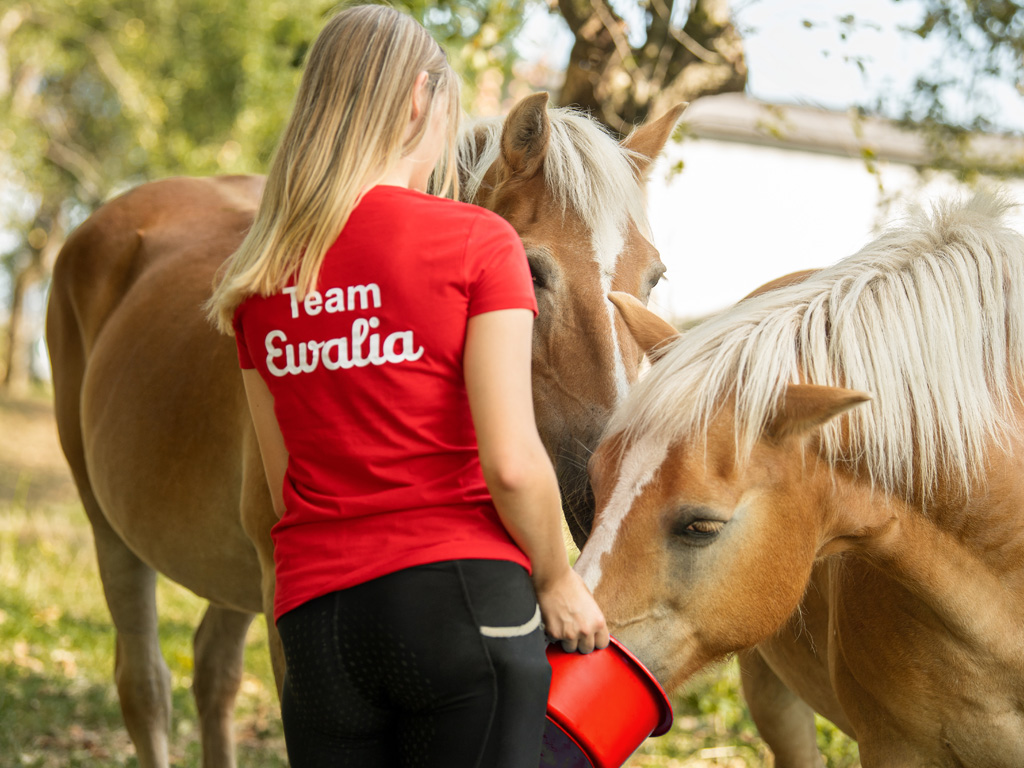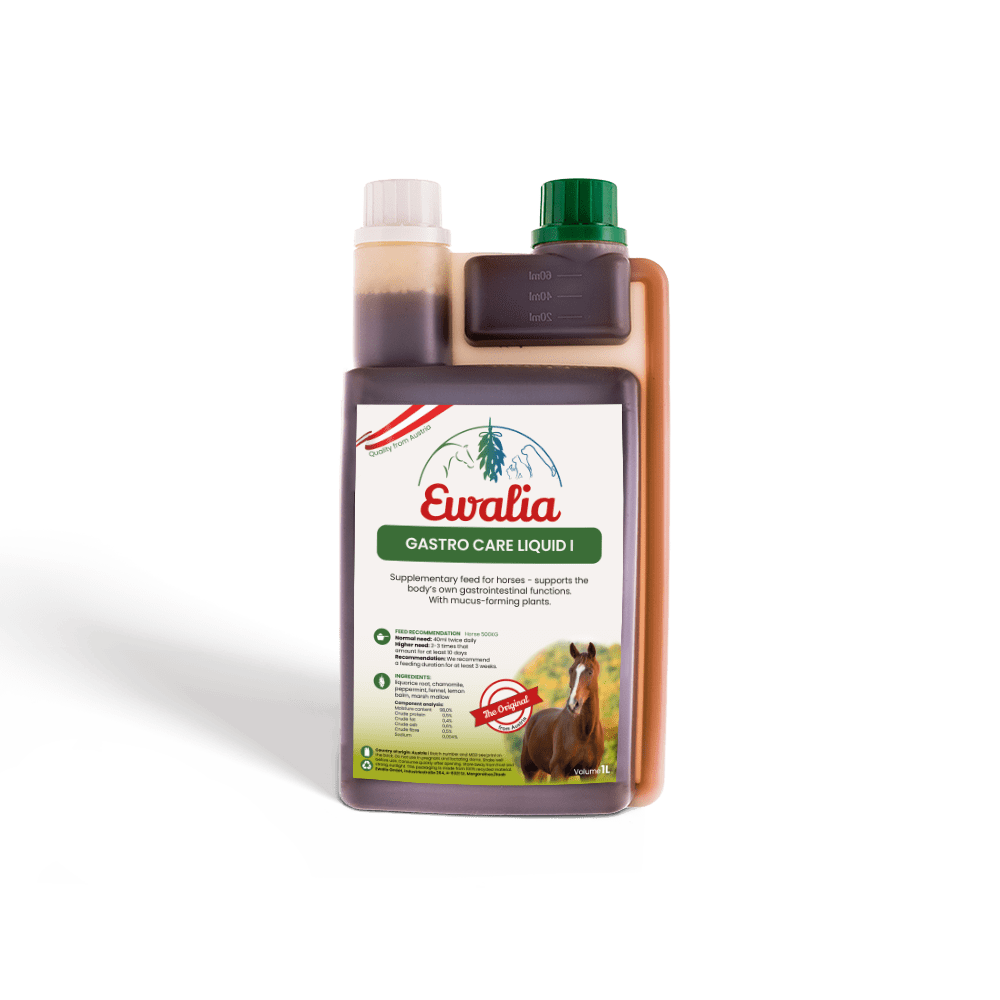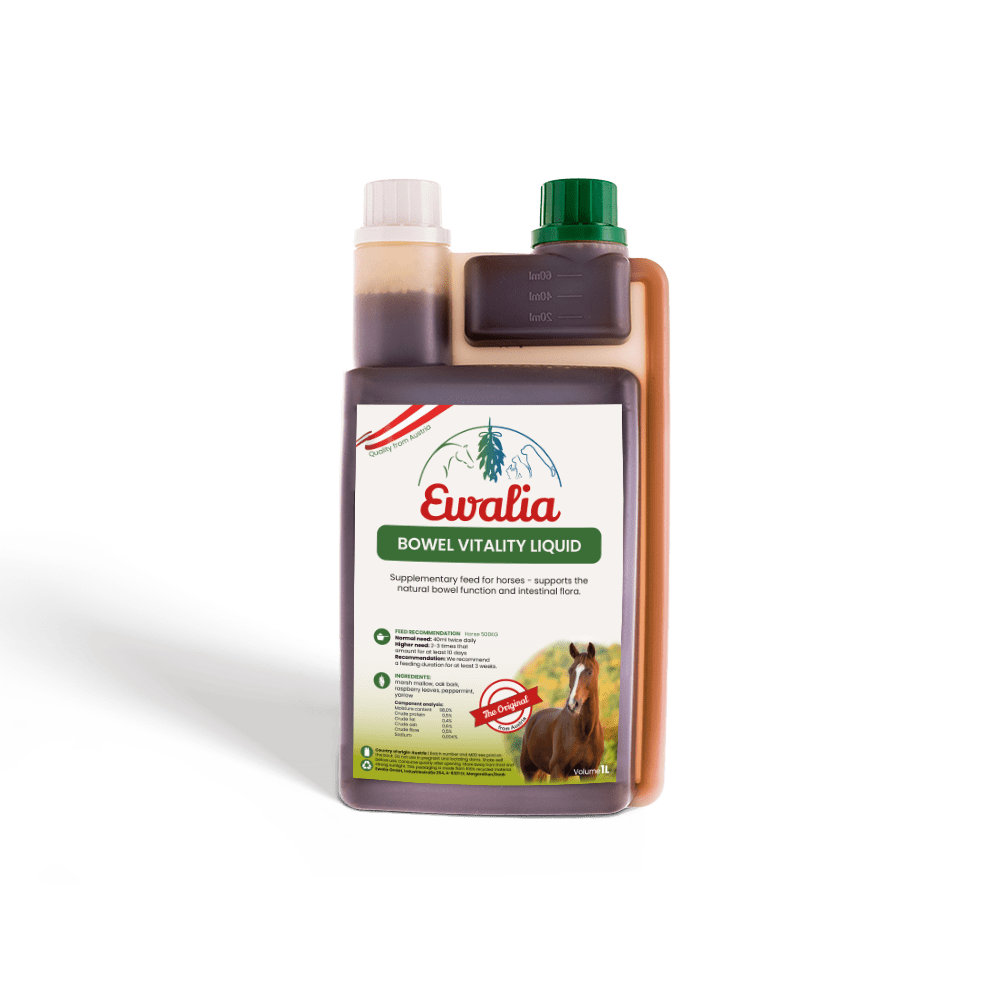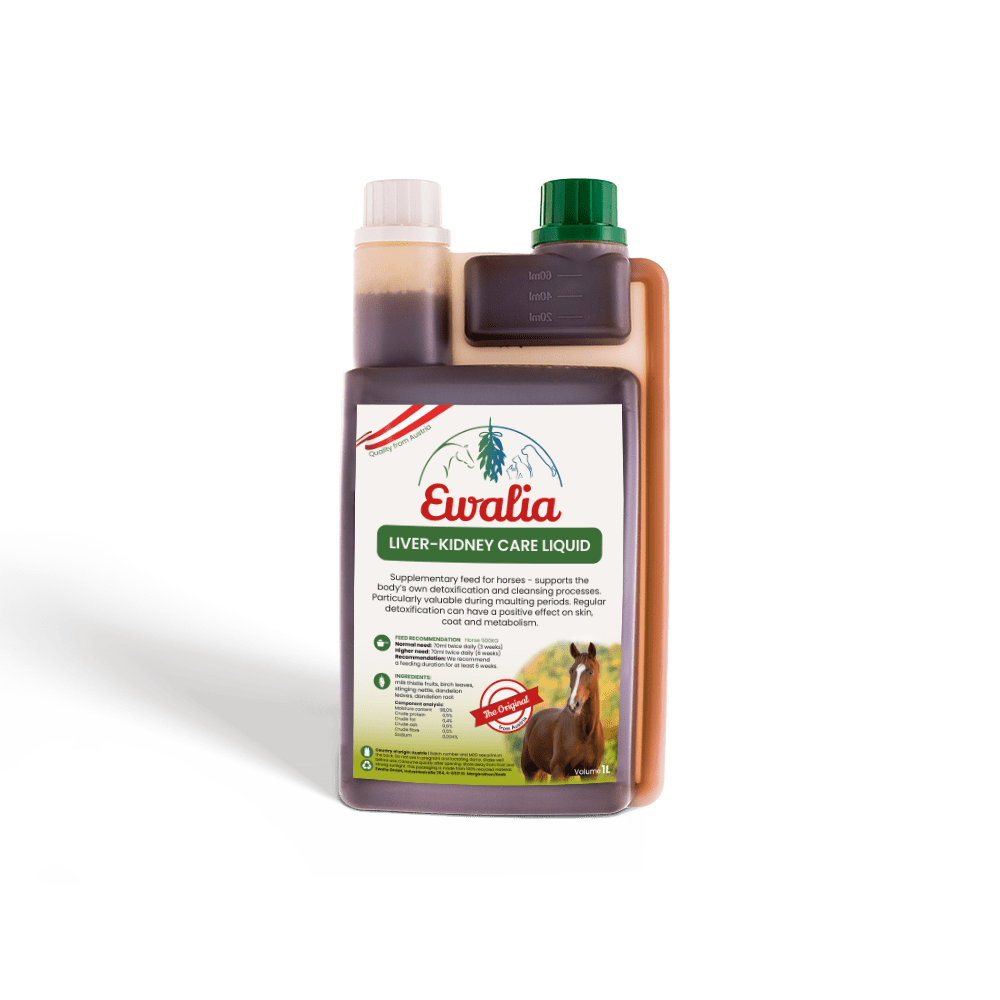Roughage: Hay, Haylage, Silage – Which is Better for Horses?
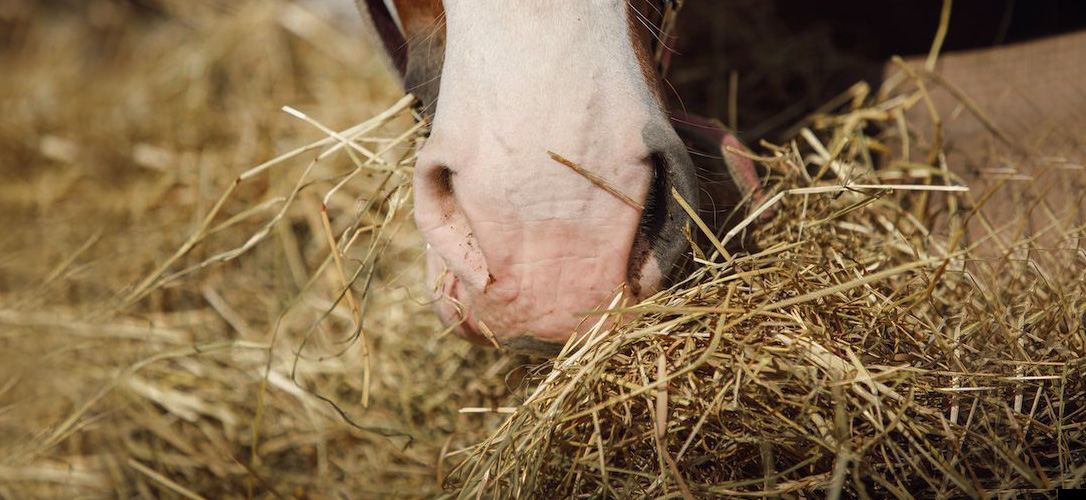
The basis for any proper equine diet is roughage. The equine digestive system is a complex one, having evolved to accommodate the constant intake of high-structure, slow-to-digest food as it is found in wild, lean grasslands. Preserved forage like hay, hey cobs, haylage and silage ensure that the horse is provided with roughage throughout the year. However, not all types of roughage are equally suitable for horses. Apart from fluctuations in quality, there are big differences in terms of tolerability. Find out what you should know about the different forms of roughage here.
What is roughage?
Roughage is understood to be feed with a high structured crude fibre content. This includes, along with pasture grass, all forms of feed in which forage is preserved:
- Hay – dried forage from fields, meadows, or pastures
- Hay pellets and hay cobs – forage that is dried, chopped, and pressed
- Silage – forage that is preserved through lactate fermentation in airtight conditions (ensiling)
- Haylage – hay that was harvested fresh and ensiled. Haylage contains less moisture than silage.
- Another type of roughage is straw. Straw has a lower nutritional value and can be fed to horses as a supplement to the hay ration as well as to keep them occupied.
Why is roughage essential for horses?
The intake of roughage forms the basis for a functioning equine digestive system. The horse's entire digestive tract is designed to digest high-fibre, cellulosic vegetation to obtain all the nutrients the organism needs.
Digestion and stomach of the horse
The digestive process begins with the intake of feed, when it is insalivated and crushed by the horse's powerful molars. A horse needs to chew approx. 3,000–3,500 times to fully chew 1 kg long-fibre hay, producing about 5 litres of saliva in the process. In comparison: chewing 1 kg of oats will produce just 1.5 litres of saliva. The mucilaginous substances in the saliva assist in the swallowing of the feed and its continued passage in the oesophagus. The saliva contains enzymes that, together with gastric acid, begin the digestion of protein. It also regulates pH values in the stomach and acts as a buffer against excess acid.
The horse's stomach is quite small, with a capacity of only about 15 litres, representing just a tenth of the volume of the entire digestive system. The constant intake of roughage means that the stomach will never be empty, as new feed will be continuously coming in, remaining there for two to six hours, and being pushed along into the gut by the arrival of yet more chyme.
A horse's stomach produces 10 to 30 litres of digestive juice every day, even if the horse eats nothing. The gastric juice contains hydrochloric acid, among other substances. Although the inner stomach wall is protected by a thick layer of mucosa, longer periods without roughage can lead to acid and digestive enzymes damaging the gastric mucosa and causing gastric ulcers. If the horse has no access to roughage for longer than 4 hours, its feed will stay in its stomach too long, making the contents of the stomach too acidic. If, for example after several hours in an enclosed yard, the horse is first fed concentrates, the stomach's pH value will rise further which can lead to gas formation and colic. It also allows bacteria and fungi to survive and migrate to the horse's gut. An old maxim from stable masters of the past: feed forage first, then concentrates!
The cellulose content of plants cannot be broken down in the horse's stomach because bacterial fermentation of chyme does not occur there. The crude fibre particles pass into the approximately 20-metre-long small intestine. These feed particles can slow down the digestive process if they are too large, e.g. because the horse ate too quickly without chewing its feed sufficiently or because of dental problems, and this can lead to gut imbalances, watery stool, and colic.
Important: if structural components in the concentrate feed (which are supposed to make the horse eat more slowly) are swallowed unchewed, this can trigger imbalances in the gut flora!
The chyme passes through the horse's small intestine relatively quickly, landing in the large intestine after just around 45 minutes. Despite such a short time period, starch, protein, sugar, and fats are sufficiently broken down in the small intestine through enzymatic digestion. A constant, slow intake of roughage ensures that the feed passes through the digestive system at just the right speed, and optimum nutrient absorption. Longer periods without eating will shorten the digestion time in the small intestine as well as the absorption of nutrients. This means that concentrates, too, will not be digested properly in the absence of sufficient roughage.
The chyme that arrives in the large intestine consists primarily of crude fibres: cellulose, lignin (a component of the woody parts of plants), and undigested proteins. Horses can digest up to 90% pure cellulose and obtain a quarter of their energy from it by converting it into sugar and fatty acids in the large intestine. The large intestine functions like a fermentation vat, in which hard-to-digest parts of food are broken down by microorganisms. Bacterial activity in the large intestine produces significant amounts of gases.
Here, too, the intake of roughage is a prerequisite for a healthy gut environment that can deal with any harmful bacteria and fungi that may have accompanied the feed from the stomach and small intestine and assist in their elimination. A diet of concentrates containing sugar, starch, and proteins but which is lacking sufficient roughage will cause changes in pH values and lead to gut flora imbalances in the large intestine, resulting in bloating, watery stool, and colic.
Important: Any changes to the gut flora will automatically lead to more strain on the liver and kidneys! Any changes to feed, whether this involves transitioning to pasture, moving yard, or larger amounts of concentrates during training, must therefore be introduced slowly!
In the hindgut (the colon and rectum), water is extracted from the contents, giving the horse droppings their typical characteristics. The digestion of roughage takes between 21 and 40 hours altogether, depending on the type and quality of feed.
Roughage for the soul
A continuous intake of roughage best approximates the natural feeding behaviours of horses. Under natural conditions, horses graze for 12 to 18 hours each day, depending on what's available, with pauses between feeding of two hours at most. Horses kept in stables or paddocks and given constant access to forage will develop a similar daily rhythm. They eat their ration over several small meals with breaks in between. Insufficient roughage and excessive intervals between meals can cause behavioural disorders and aggression within the herd. This is because horses are "programmed" to chew a certain number of times. Wild horses that must nibble on hard, woody stalks need 60,000 chews per day to make them feel full. Domesticated horses, who receive much better feeds, need 35,000 chews per day – and even that is too much for some horses. Horses suffering from obesity and/or metabolic disorders like PSSM and EMS do well with slow-feeder hay nets and racks; these simulate slow, selective feeding and can lengthen feeding times, as individual stems must be chewed too, after all.
For our generally underoccupied horses, the chewing of roughage is feed intake, activity programme and stress reliever in one: roughage contains the amino acid L-Tryptophan, essential for production of serotonin, aka the "happiness hormone".
Why should I feed my horse hay?
Hay is the most important form of roughage for horses. Meadow hay comes closest to horses' original food supply in the wild. It has an ideal crude fibre structure, requires thorough chewing, and helps to regulate digestion. It contains protein, sugar, vitamins, and trace elements. Sun-dried hay has lots of vitamin D. The nutritional value of the hay may fluctuate according to composition, cutting time, and quality, or decrease when ensiled for longer periods.
Theoretically, a non-working horse can live on hay alone if his ration is supplemented with minerals. A horse in maintenance should be fed at least 1.5 kg (or better yet, 2 kg) of meadow hay per 100 kg of body weight, and not less than 1 kg per 100 kg of body weight.
Tip: Weigh the hay ration every now and then, because it's quite easy to over- or underestimate!
These days, most horse owners don't have large farms with hayfields, and they mostly buy commercial hay. The modernisation of agriculture with enormous tractors, efficient mowers, hay tedders, and giant balers has made the production of preserved forage much easier but has also had negative effects on its quality. Bales often also contain moulds, dirt, stones, or even dead mice. That's why it's crucial that you look closely at the hay that you are feeding to your horse!
Which hay is good for my horse?
Good horse hay is hard and stalky, green in colour, and smells pleasantly of hay flowers. Ideally, areas for hay production contain diverse vegetation without excess fertilisation. Do not harvest hay from fields that contain poisonous plants like meadow saffron, ragwort, or bracken! These plants will sometimes be eaten along with the hay!
The best hay for horses is meadow hay that has been harvested between late May and late June, when the grasses are still in flower. Grasses cut after they have finished flowering will have a woodier structure. These will have less nutritional value, as most of the important substances are found in the leaves, flowers, and seeds. However, straw stalks to chew on helps to relieve boredom in overweight horses and keep them in good spirits. Keep in mind that extremely coarse hay may cause impaction and colic in older horses and others that do not adequately chew their feed.
Tip: Early cut, "too good" hay can be watered before feeding it to horses with insulin resistance or PSSM or to heavy breeds which cannot tolerate sugar. Important: Dispose of the water afterwards, as it contains a lot of sugar and horses will drink it with pleasure! Remove leftover hay at once, especially in summer, as wet hay spoils very quickly.
Soft, dark green, leafy hay cultivated for milk cows is cut too early to be suitable as horse hay. The mostly shorter, soft hay from the second cutting, sometimes called the "rowen" is also unsuitable as a base forage. The fewer stems the hay contains, the lower the share of crude fibres and thus the higher the protein content. Even if it looks good, it should only be fed in moderation, as horse hay should contain at least 20% crude fibre. The exceptions to this are lactating mares, foals, underweight horses, and senior horses, all of whom benefit from the higher nutrient content and softer consistency of second cut hay.
Important: Hay that is harvested in early autumn is often still moist and must be aged longer until the germ flora in the hay has stabilised!
Lucerne hay has about 20% crude protein (much more than the 7–15% in meadow hay) and is high in calcium. Horses in hard work, young horses, and horses with stomach problems can be given lucerne hay to replace part of the concentrate ration. Although horses find lucerne hay quite palatable, caution is advised when feeding it to easy doers, ponies, and other robust breeds, as excessive protein intake can cause metabolic disorders.
Today, hay is usually left to dry on the ground after cutting, where it is turned frequently with a tedder. This causes losses through leaf shatter, i.e., some of the leaves and flowers fall away. In dry, hot weather the hay can be baled after two or three days. Drying may take up to two or three weeks if the weather is uncooperative. The hay's moisture content should in any case be less than 20% before it is brought in.
Ground drying is almost impossible at higher elevations where the dew is slower to evaporate. There, hay was traditionally dried on hay on wooden frames, which required enormous effort. This method has been largely supplanted by hay drying systems which heat the hay to a maximum of 70°C, causing the moisture to evaporate. Hot air drying diminishes the hay's nutritional value, as its vitamins and proteins can no longer be fully utilised by the horse. If the hay is dried too quickly and through excess heat, it takes on a brownish colour and emits a burnt odour which horses do not find palatable.
Rained-on hay can be recognised by its pale colour. It contains less sugar and fewer minerals as these will have been washed out. If the hay can dry after the rain, it can still be used as feed in combination with a good mineral mix.
Fresh hay must be left to rest for eight to twelve weeks after cutting before it can be used as feed. During the first weeks of storage the hay will go through a "sweating phase" in which it loses more moisture. The hay warms up in the process and the steam seeps from the core of the hay bale to the outside. "Sweating" hay feels damp and clammy at the edges. These warm, moist conditions lead to bacterial growth. The increased bacteria in partially fermented hay can cause digestive disorders and colic if ingested.
If too much residual moisture remains in the hay, bacteria and mites will increase unchecked and moulds will take up residence. Mouldy hay smells musty or even of decay. Often, mould forms in the hay bales which make dust when pulled apart, or patches of white mould are present. Do not feed mouldy hay to horses, as it may cause diarrhoea, colic, allergies, and respiratory ailments! Likewise, hay contaminated with soil or dust is also unhealthy for horses! The horses cough, the carefully watered hay spoils too quickly. Actually the whole bale should be thrown out – but where?
Storing large bales poses additional problems: due to lack of space in the barn, the hay is often left outside and covered with plastic, under which mould forms. Even inside the barn, damp, cold winters can cause the bales to go mouldy from condensation.
It's no wonder, then, that horse owners look for alternatives to hay for their horse feeds – but are there any?
Can hay cobs/grass cobs/lucerne cobs/hay pellets replace hay rations?
In years with bad hay harvests, hay cobs can be used to replace at least part of a horse's forage, particularly for horses that are underweight, elderly, or with dental issues. These cobs are made from green plants that are gently dried with warm air and then chopped and pressed. Little is lost in the drying process and so their nutrient content corresponds to that of unprocessed hay. They even contain more vitamin E and more β-Carotene than conventional hay. Soak the large pellets before feeding, as they swell considerably and otherwise present the risk of oesophageal obstruction or stomach overload.
Tip: Dispose of the water used to soak the cobs, as some cobs contain considerable amounts of sugar!
Hay cobs are no substitute for hay for healthy horses: they become a soft mash that requires less chewing, which can lead to pH imbalances in the gastrointestinal tract. Hay cobs do not provide horses with the amount of chewing activity and feeding duration they need. Feeding a horse smaller portions at intervals of 3 to 4 hours is difficult to implement in practice.
Should I feed my horse straw?
Low-nutrient straw is well suited to keep horses occupied with chewing. Straw contains lots of crude fibre that requires longer chewing, and slowly eaten straw provides bulky, fibrous material for the digestive tract. Straw has a high amount of cellulose and lignin which give it its woody consistency. Horses cannot digest lignin.
Good feed straw must be clean and free of harmful substances such as sprays. Organic straw from unsprayed fields should be inspected closely before purchase, as some weeds, such as field bindweed or plants of the genus Apera, can cause colic when eaten in large quantities. Straw that is grey or dusty indicates the presence of mould. Do not use mouldy straw as bedding, as it can tax the animal's airways.
Daily hay rations can be "stretched" with a maximum of 1 to 2 kg of clean straw if hay is in short supply or if the horse needs to lose weight.
Important: Large quantities of straw can affect the gut flora and lead to impaction colic! Feed straw should be no shorter than 5 cm!
Depending on the region, there are various types of straw available which are suitable for horses. Wheat straw is hard, golden yellow, and consists primarily of stalks. Horses find it extremely palatable.
Barley straw is lighter in colour, softer, and also quite suitable for horses. The grass awns, the dread of dog owners, are not dangerous for horses, but barley straw often contains high amounts of silky-bent, which can cause impactions.
Oat straw is leafier and contains more nutrients, including silicic acid. It must be thoroughly dried before being brought in, as it is easily subject to moulds.
Rye straw has the longest and hardest stalks and also contains the most lignin and crude fibre. It has a bitter taste which horses do not like.
What is silage and what is haylage?
Silage
Silage is produced mostly from grass. Unlike with hay, the grass for silage is not left to dry in the field but is firmly pressed when still moist shortly after wilting and then tightly wrapped in several layers of strong plastic sheeting. The ensiling process starts in the compressed bales: the proliferation of lactic acid bacteria ferments the sugar in the grass and preserves the grass. This process stops once a pH value 5 is reached and "dormancy" occurs, meaning that germs and moulds can no longer grow in the acidic environment. This, by the way, is quite similar to the process of making sauerkraut.
Grass that is short and leafy – and thus high in sugar and protein – is ideal for silage because it provides an ideal environment for the growth of lactic acid bacteria. Because grass silage is mostly fed to cattle, the aim is to achieve the highest possible energy content – something not suitable for horses. The grass is cut before flowering, making it too short for horses. In grass silage for horses, the stems should be at least 6 cm long.
At first glance, production appears quite practical: the grass must not be left lying so long, and it should have a moisture content of 50 to 75%. Experienced farmers can make silage in one day, so they are not dependent on longer periods of good weather. Silage is only turned once, so there is less leaf shatter. However, there are also some things to consider. The fields must be thoroughly dragged in the spring. The grass should not be cut too close to the ground to prevent contamination from soils that may contain harmful bacteria. Silage should not be made from fields that are fertilised with poultry manure, as chickens are often infected with clostridium which they eliminate with their droppings. The lack of air causes not only the proliferation of lactic acid bacteria but also of harmful bacteria such as listeria and clostridium, which can cause colitis X or botulism, depending on the strain.
Silage is very moist. If you pull a handful of it out of a bale, it will still be dripping wet. Good silage has an aromatic, pleasant smell and horses like to eat it. Its moisture content keeps it damp and prevents dust, which is why it is sometimes recommended for horses with respiratory allergies. The nutritional composition of silage resembles that of pasture grass. Tightly packed and stored away from sunlight, it will also keep well outdoors. Once opened, however, bales must be used as quickly as possible before the silage spoils from refermentation. With a bale weight of approximately 400 to 600 kg each and a consumption of approximately 10 kg per horse per day, the feeding of silage is only practical for larger yards.
Haylage
Unlike silage, haylage is produces specifically for horses. The grass for haylage is cut when it is in flower and has a higher proportion of stalks and less protein and sugar. It is also dried longer than silage before pressing, namely to a moisture content of 25–50%. Haylage is therefore hay that is not fully dried that has undergone lactic acid fermentation in the absence of air.
However, mishaps frequently occur during the production process: the large stalks hinder the required tight compression and air pockets remain in the bale, preventing complete ensilage from taking place. Hard stalks sometimes pierce through the plastic wrapping, causing the bale to spoil. The lower water, sugar, and protein content offers suboptimal conditions for the growth of lactic acid bacteria. The desired pH value of 5, at which dormancy occurs, is reached only slowly or not at all. The pH value of haylage stagnates at 6.0 to 7, increasing the risk of mould infestation which may not be noticeable because haylage does not create dust.
Once the bale is opened, the haylage must be used within two to three days, as its gas-forming yeasts will continue to ferment and warm in the bale. The yeasts break down the lactic acid that preserves the feed. The higher pH value increases the risk of contamination from bacteria. Large bales of haylage are therefore unsuitable for private horse owners. Well-ensiled haylage pressed into small bales is difficult to find.
Hay or haylage – which is better for my horse?
Every so often we have a year with a shortage of good hay because it either rained all summer long, or not at all. Sometimes the only hay available is bristly and over-mature; other times just looking at a bale of hay will make it go dusty. Or perhaps your vet has recommended haylage because your horse coughs every time it eats hay. Or your yard has a feed expert who's convinced that haylage cannot harm horses because it has the same pH value as the horse's stomach, and anyway the saliva from chewing neutralises the acidity.
In any case, a reach into the fragrant hay bale should be your first choice. But before you feed your horse mouldy hay (or none at all), sometimes you'll have no other option than to compensate for a short supply of roughage by feeding him haylage. Keep in mind, however, that haylage can put considerable strain on the equine organism. Ensiled feed puts large quantities of lactic acid bacteria into the entire digestive tract, changing the gut microbiome. Over time this leads to hindgut acidosis and to inflammations of the intestinal epithelium, with symptoms like foul-smelling faeces, diarrhoea, or watery stool. The lactic acid bacteria break down carbohydrates and proteins, but then convert them into lactic acid which must be broken down in the liver. If the lactic acid bacteria get the upper hand in the gut, it will impair the proper digestion of cellulose from plants. Long-term symptoms include:
- Lack of energy despite sufficient energy intake
- Fatigue and poor performance
- Tissue acidosis with fluid accumulation
- Strained immune system, watery stool, allergies
- Considerable strain on the liver and kidneys from acidosis and the undetected mould in the feed
- Vitamin deficiencies through the changed gut flora
- Digestive disorders from lactic acid and bacteria, such as watery stool, bloating, diarrhoea, and colic
What can I do if my horse was fed incorrectly?
Things go wrong sometimes, even in the best yards and with the most careful management. Maybe you were in a hurry one evening, or someone fed your horse with the best of intentions, and in the morning, you found the remains of mouldy hay in the manger.
Or the yard owner must switch to haylage or straw temporarily due to a shortage of hay.
If a horse apparently cannot tolerate haylage and shows signs like watery stool, bloating, or diarrhoea, he should be switched back to hay as quickly as possible.
These herbs can help the horse:
Herbs containing mucilaginous substances, bitter substances, and tannins will help support the irritated intestinal epithelium and bring urgently needed regulation to the digestive system.
- Marsh-mallow has soothing mucilaginous substances to promote the regeneration of the stomach and intestinal lining.
- Yarrow helps to stabilise the gut flora and helps relieve bloating and cramps.
- Oak bark can relieve diarrhoea and watery stool caused by bacteria.
Diuretic and liver-protecting herbs help to reduce strain on the liver and kidneys and promote the body's own detoxification processes.
- Milk thistle protects the liver from harmful substances and promotes liver cell regeneration.
- Dandelion has diuretic properties, promotes bile production, and boosts digestion.
- Birch leaf increases urine output and has mild diuretic effects.
- Stinging nettle helps to cleanse the kidneys.
Sources and further reading
- Coenen, M., & Vervuert, I. (2020). Pferdefütterung (6. Ausg.). Stuttgart: Georg Theme Verlag KG.
- Fritz, C. (2002). Pferde fit füttern. München.
- Fritz, C., & Maleh, S. (2016). Zivilisationskrankheiten des Pferdes. Thieme.
- Futterkonservierung, F. F. (2006). Futterwerttabellen für das Grundfutter im Alpenraum. Irdning: Österreichische Arbeitsgemeinschaft für Gründland und Viehwirtschaft.












